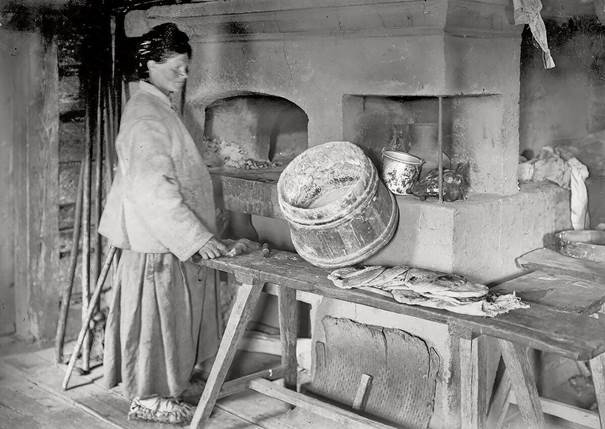“Woman’s Corner”: Why in Russia Women Were Forbidden to Dine at the Same Table with Men

In the 16th century, the German baron Sigismund Herberstein wrote about the extremely “deplorable situation” in which Russian women found themselves. They were not allowed to do many of the things that men were allowed to do. It was impossible even to sit at the same table during lunch. This prohibition seems strange today, although our ancestors had their own reasons for such rules.
Terem is a prison
In the homes of well-to-do families, living space was traditionally divided into male and female. While men had complete freedom of movement, women spent most of their time on the women’s side. For a long time, the main women’s occupations were needlework and prayer. Even if guests came to the house, a woman could go out to them only with the permission of the eldest man in the house – her father or husband. And it was inconceivable that she would be allowed to sit at the common table.
An explanation of this custom can be found in N. Pushkareva’s book “The Private Life of a Woman in Ancient Russia and Muscovy”. A historian and expert on “women’s issues” writes that the desire to hide a woman from prying eyes dates back to the times when there was a threat of losing a wife or daughter after another raid.
But why did the women have to sit in the terem not only during the arrival of guests, but also on other days? Why weren’t they allowed to dine with the men every day? According to N. Pushkareva, one of the reasons for seclusion is the adoption by Orthodoxy in Russia of the Byzantine idea of the sinfulness of women. The Terem was perceived as a monastery in which a woman “purifies herself” in solitude. It is no coincidence that the strictness of the terem seclusion was resorted to from the moment when the girl’s first regula came, and she became “impure”.
Byzantine misogynists insisted that the “vessel of sin” should be kept away in order to avoid temptation and sinful fall. This idea, firmly rooted in the Orthodox consciousness, partly explains why men in Russia were in no hurry to invite women to their table.
On the Other Side
In the peasant environment, women lived more freely, because to work in the field and garden, like it or not, you would have to go outside. But even in the hut there was a division into the male part and the so-called “woman’s corner”. During lunch, the woman’s main task was to feed the workers, so she simply had no time to sit down at the table. I had to serve, trim, and put it in.
But in addition to the obvious reason, there is another. In the article “The Idea of the Ritual Impurity of a Woman in Traditional Culture” Y. Treschenok reminds about the pagan principles of perceiving the essence of a woman. Her ability to bear children inextricably linked her with the other world and death. It is no coincidence that in folklore Death has always appeared in a female form, and a woman’s womb has been associated with the grave.It is no coincidence that T. Listova in her article “The Impurity of a Woman in the Customs and Ideas of the Russian People” cites a large number of ethnographic examples when a woman had to observe certain prohibitions. In the days of “uncleanness” in many regions, she was forbidden to pick apples, plant potatoes and water the beds. In the Oryol province, it was forbidden to “take care of bread” – to knead dough, bake a loaf, and serve it on the table.
In addition to bread, which was considered sacred, women were forbidden to touch Christian attributes, including kissing icons, on the days of “uncleanness”. After giving birth, for 40 days, the woman in labor was not allowed to enter the barn, milk the cow, set and remove the table. According to a widespread tradition, during “blood” and pregnancy, women were not allowed to eat together. This prohibition was especially strictly observed by the Old Believers.
God’s Throne
As V. Artemov notes in the Slavic Encyclopedia, in a peasant hut the table was no less important an attribute than the stove and the red corner. In the newly built hut, the table was brought in first, then they prayed, and only after that they continued to bring in other things. The table figured in many ceremonies.
The sacred attitude to it is expressed by the Russian proverb “In the house, the table is God’s throne.” It is no coincidence that there were many prohibitions on behavior at the table. Sitting behind it, it was forbidden to make noise, laugh, sit in a hat or with crossed legs. It was forbidden to sit on the table or put one’s feet on it. It was allowed to move the table only in exceptional cases – for a wedding or during a funeral.
People sat at the “throne of God” “according to their rank.” The eldest man is at the head, then the rest of the family. Male breadwinners sat on benches at the table. Women and children are on the side of the wall. Those sitting at the table began their meal only after the older man had “taken a sample.” We all finished lunch together. It was forbidden to “break the table”, that is, to stand up at random after the end of the meal.
When one considers all the prohibitions that the church has imposed on women over the centuries, it is easy to see why women had no place behind “God’s throne.” Thus, in Byzantium, women were forbidden to enter men’s monasteries and Mount Athos. A woman cannot become a “vicar of God on earth,” that is, a priest. She cannot enter the altar, and according to early Christian tradition, during church services, women must stand separately from men.
